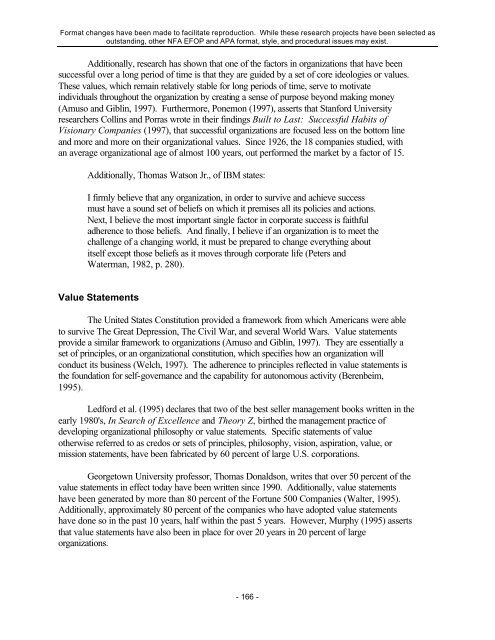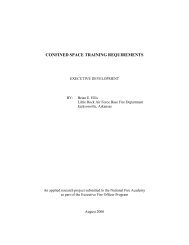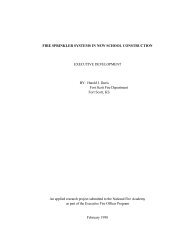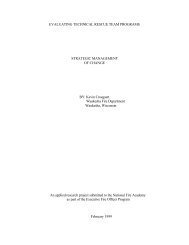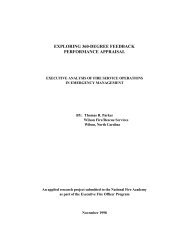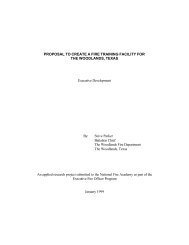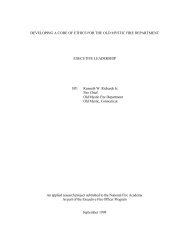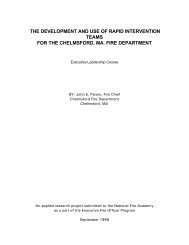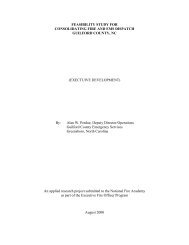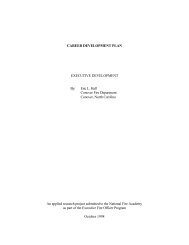Value Statements - US Fire Administration
Value Statements - US Fire Administration
Value Statements - US Fire Administration
Create successful ePaper yourself
Turn your PDF publications into a flip-book with our unique Google optimized e-Paper software.
Format changes have been made to facilitate reproduction. While these research projects have been selected as<br />
outstanding, other NFA EFOP and APA format, style, and procedural issues may exist.<br />
Additionally, research has shown that one of the factors in organizations that have been<br />
successful over a long period of time is that they are guided by a set of core ideologies or values.<br />
These values, which remain relatively stable for long periods of time, serve to motivate<br />
individuals throughout the organization by creating a sense of purpose beyond making money<br />
(Amuso and Giblin, 1997). Furthermore, Ponemon (1997), asserts that Stanford University<br />
researchers Collins and Porras wrote in their findings Built to Last: Successful Habits of<br />
Visionary Companies (1997), that successful organizations are focused less on the bottom line<br />
and more and more on their organizational values. Since 1926, the 18 companies studied, with<br />
an average organizational age of almost 100 years, out performed the market by a factor of 15.<br />
Additionally, Thomas Watson Jr., of IBM states:<br />
I firmly believe that any organization, in order to survive and achieve success<br />
must have a sound set of beliefs on which it premises all its policies and actions.<br />
Next, I believe the most important single factor in corporate success is faithful<br />
adherence to those beliefs. And finally, I believe if an organization is to meet the<br />
challenge of a changing world, it must be prepared to change everything about<br />
itself except those beliefs as it moves through corporate life (Peters and<br />
Waterman, 1982, p. 280).<br />
<strong>Value</strong> <strong>Statements</strong><br />
The United States Constitution provided a framework from which Americans were able<br />
to survive The Great Depression, The Civil War, and several World Wars. <strong>Value</strong> statements<br />
provide a similar framework to organizations (Amuso and Giblin, 1997). They are essentially a<br />
set of principles, or an organizational constitution, which specifies how an organization will<br />
conduct its business (Welch, 1997). The adherence to principles reflected in value statements is<br />
the foundation for self-governance and the capability for autonomous activity (Berenbeim,<br />
1995).<br />
Ledford et al. (1995) declares that two of the best seller management books written in the<br />
early 1980's, In Search of Excellence and Theory Z, birthed the management practice of<br />
developing organizational philosophy or value statements. Specific statements of value<br />
otherwise referred to as credos or sets of principles, philosophy, vision, aspiration, value, or<br />
mission statements, have been fabricated by 60 percent of large U.S. corporations.<br />
Georgetown University professor, Thomas Donaldson, writes that over 50 percent of the<br />
value statements in effect today have been written since 1990. Additionally, value statements<br />
have been generated by more than 80 percent of the Fortune 500 Companies (Walter, 1995).<br />
Additionally, approximately 80 percent of the companies who have adopted value statements<br />
have done so in the past 10 years, half within the past 5 years. However, Murphy (1995) asserts<br />
that value statements have also been in place for over 20 years in 20 percent of large<br />
organizations.<br />
- 166 -


